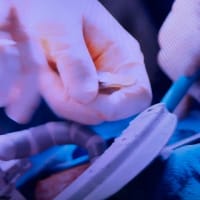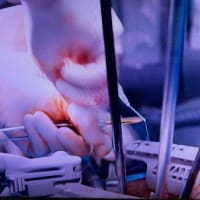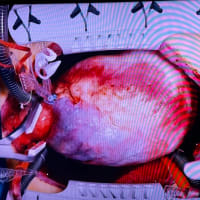急性大動脈解離の断端形成や左室壁の縫合など脆弱な組織の吻合を行う際はPTFEフェルトなど補強剤を用いて断端形成してから縫合操作を行うことで組織のカッティング予防や針穴出血の防止ができ、安全な手術に貢献している。
新しいPTFE織布であるニットパッチ®は、組織代用人工繊維布として保険償還が認められたが、心臓血管手術における脆弱部縫合の補強に使用することは特に有用性がある。
ニットパッチは従来のPTFE線維の不織布フェルトと違い、PTFE線維を密に編んだ基布にPTFEのマイクロパーティクルを含浸させてゼロポロシティとしたもので、従来の不織布フェルトよりも薄いが耐久性は同等で、とくに針穴からの出血もIn Vitroのデータでは半分以下と止血性に優れる。
当施設でもニットパッチの心臓血管手術においての使用を経験しその有用性を実感している。
使用実績として急性大動脈解離4例、上行~弓部大動脈瘤4例の内外二重断端形成、MICS-AVRにおける薄く脆弱な大動脈切開閉鎖の外側補強2例、AFMRに対する心房縫縮術の薄い右房壁縫縮の補強2例、左室形成術における左室縫合の補強1例(Exclusion Patchにも同素材品使用)、AVR術後PVFにおけるApico-Aortic Conduitの心尖部縫合における縫合糸の補強プレジェットとして使用した2例、AVR術後のSuicide Left V entricleにおけるMCS離脱不能例に対するApical Myectomy部の縫合部補強1例、Commando手術における大動脈および左房上壁修復1例に使用し、いずれも針孔出血はなく、止血操作が容易であった。
針穴出血の少ない新材料の使用は手術時間の短縮と輸血需要の現象をもたらし、また薄い素材で大動脈内突出による内腔狭窄や溶血も予防でき有用である。パッチが薄く柔らかい点は組織の支持力がなく、容易に裏返ったりするため大動脈解離の断端形成には縫合時にコツと慣れが必要で、布の厚さや硬さが選べる容易になるとより操作性が向上すると考えられた。従来の不織布フェルトよりも高額であるが、ウシ心膜をよりも安価であり、出血が少なく輸血量が減少するならばコストも許容できると考えられる。
Experience with a new tissue-substitute artificial fiber fabric knitted patch in cardiovascular surgery
Introduction When performing anastomosis of fragile tissues, such as in acute aortic dissection, using a reinforcing agent such as PTFE felt to form the dissection before anastomosis prevents cutting of the tissue and needle hole bleeding, contributing to safe surgery. Similarly, the use of a reinforcing agent for suturing fragile cardiac tissue can also prevent bleeding at the suture site.
Objective To report on the usefulness of a new tissue-substituting artificial fibre fabric, the knitted patch, for the reinforcement of sutures in vulnerable areas in cardiovascular surgery.
Material Unlike conventional non-woven felt made of PTFE fibres, the knitted patch is made of a densely woven PTFE fibre base cloth impregnated with PTFE micro-particles to achieve zero porosity, which is thinner than conventional non-woven felt but has the same durability, especially in terms of bleeding through needle holes, which is less than half of that of conventional non-woven felt according to in vitro data, indicating excellent haemostasis.
Methods We report our experience with the use of knitted patches in cardiovascular surgery at our institution.
Results Two cases of acute aortic dissection, one case of internal and external double-sectioning of an ascending aortic aneurysm, one case of external reinforcement of a thin and fragile aortotomy closure in aortic valve replacement using a lateral small open approach, one case of reinforcement of a thin right atrial wall suture in atrial suture for AFMR, one case of reinforcement of left ventricular suture in left ventriculoplasty (Exclusion) One case of reinforcement of the apical suture of the Apico-Aortic Conduit in a PVF after AVR, one case of reinforcement of the apical suture of the Apico-Aortic Conduit in a Suicide Left V entricle after AVR, one case of reinforcement of the MCS in a case of failure to detach the MCS in a left ventriculoplasty (the same material was also used in the Exclusion Patch). In all cases, there was no needle hole bleeding and only bleeding at the displacement of the sutured tissue, which facilitated bleeding control.
Discussion The use of a new material with less needle hole bleeding is useful in reducing operative time and blood transfusion demand, and the thin material also prevents luminal narrowing and haemolysis due to intra-aortic protrusion. The thin and soft point of the patch does not provide tissue support and easily flips over, so aortic dissection transection requires knack and familiarity when suturing, and it was thought that easier selection of cloth thickness and hardness would improve the operability of the patch. Although more expensive than conventional non-woven felt, it is less expensive than bovine pericardium and the cost is considered acceptable if blood loss is reduced and transfusion volume is reduced.
Conclusion Knitted patches made of new materials improve the quality of cardiovascular surgery.



















